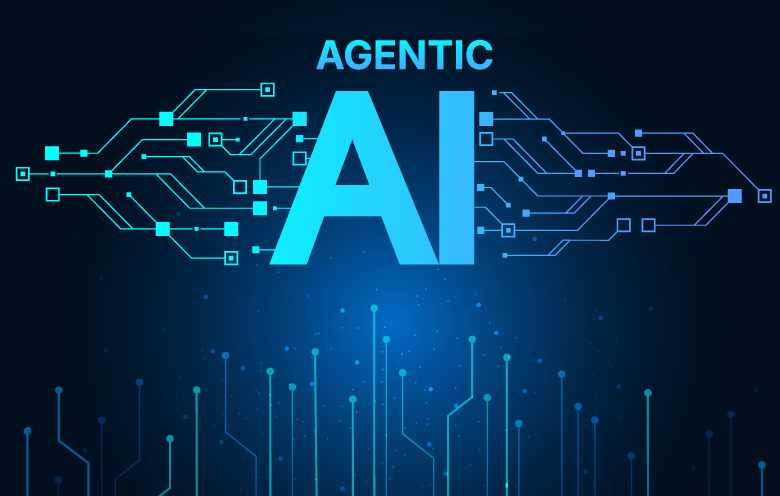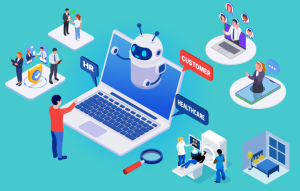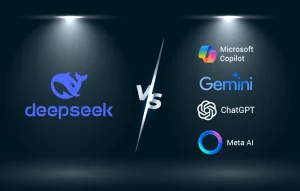What if artificial intelligence (AI) could think and act like ‘a trusted advisor’? This is the concept of ‘agentic AI’, a form of AI that can make decisions and take actions on behalf of its users.
The above question matters to the C-suite as they prefer to invest time in:
- responding to unexpected events
- aligning a heterogeneous workforce
- managing conflict in the decision-making process
- balancing short-term priorities with long-term growth goals
- enabling experimentation and learning while ensuring efficiency and effectiveness
For the C-suite, anything beyond the priorities listed above risks distraction. For the top leaders, it is not about time management anymore. It is about distraction management. The ‘agentic’ in agentic AI is to take care of such interruptions. With AI’s ‘agentic properties’, technology has made a giant leap in how humans interact, use, and collaborate with AI.
What is ‘agentic’ in agentic AI?
Agentic AI is not just another AI. It’s a system that possesses the qualities of an agent, particularly in terms of autonomy and self-direction. It’s the kind of AI that can take independent actions, achieve goals, and learn from feedback.
Imagine having an AI that doesn’t just crunch numbers but understands the ‘why’ behind every choice and can make instant decisions. This is the power of agentic AI. It can dynamically re-configure your supply chains in response to geopolitical or weather disruptions or engage in realistic customer interactions by pulling information from multiple datasets – like CRM, supply chain, and customer policies – to resolve issues.
Suggested: Do you want to know in detail about what is agentic AI, key differences between agentic and non-agentic AI, benefits of agentic AI, and more? Consider giving yourself three minutes to read this blog.
Do you know with AI agents, you can achieve goals like:
- Maximize sales
- Improve customer satisfaction scores
- Enhance efficiency in supply chain processes
- Liberate the sales team from time-consuming activities
- Increase productivity and quality while reducing energy consumption and carbon emissions from production lines
Like above, there are many applications of agentic AI. In any application or use case you take of agentic AI, you will find one thing in common: it automates information handling by understanding the ‘why’ behind every choice.
How does agentic AI understand ‘why’ from Softweb Solutions’ viewpoint?
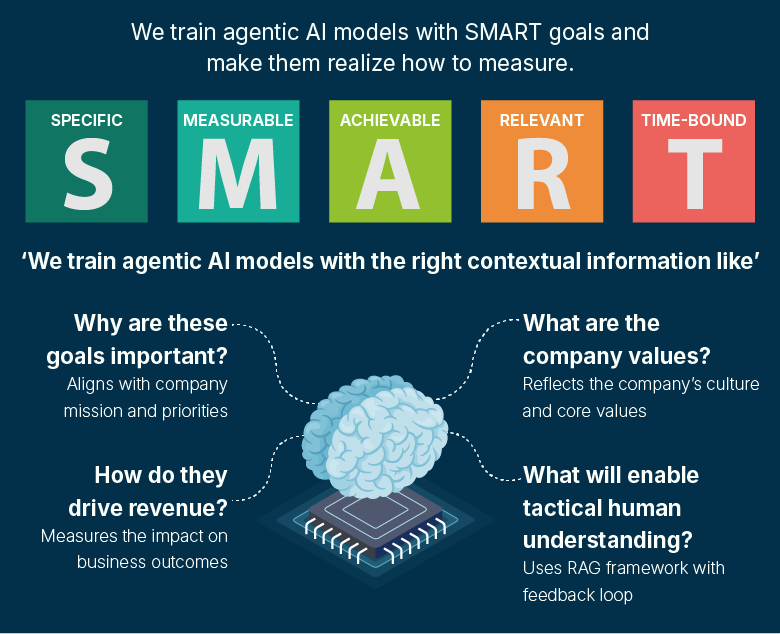
Do you want autonomous agents for your enterprise tasks?
Explore Needle – our RAG-powered GenAI framework for your dynamic enterprise workflows.
That’s exactly why and how agentic AI can transform decision making for the C-suite, acting not just as a tool, but as a trusted advisor. This blog answers to ‘how’. How agentic AI revolutionizes decision making for the C-suite. Since we do not want to throw just a flashlight in a fog, we have leveraged Clayton Christensen (a renowned American academic and business consultant)’s Jobs to Be Done (JTBD) framework.
Traditionally, decision-making in enterprises focuses on two key factors: establishing themselves as industry leaders and being finance-savvy. In a time, when:
- new products emerge faster,
- workforce diversity expands,
- firms face greater public scrutiny than ever before, and
- business operations grow more complex and tech-centered,
the C-suite needs a paradigm shift in how they approach strategy.
In such a dynamic landscape, the outcome-driven JTBD framework provides that shift by focusing not on the customer as an individual, but on the “job” they aim to accomplish.
Unique insight
When companies prioritize helping their customers complete a job faster, more conveniently, and less expensively than before, they are more likely to create products and services that the customer wants.
At its core, the JTBD framework dives deep into understanding the ‘real job’ a customer wants to achieve. For the C-suite, this job is decision making – not just informed, but confident and decisive. The framework emphasizes three crucial aspects:
- Functional jobs: What must be done?
- Emotional jobs: What reassures and motivates decision makers?
- Social jobs: What drives confidence in external stakeholders?
Suggested: Humans can recognize, interpret, and act. So, the agentic AI. With such expertise and more, learn about the three key reasons you should future proof your business with agentic AI.
Agentic AI directly aligns with these dimensions. It does not just process data. It anticipates needs, mitigates uncertainties, and adapts dynamically. By applying the JTBD framework, agentic AI becomes more than a technology – it becomes a powerful enabler of outcomes.
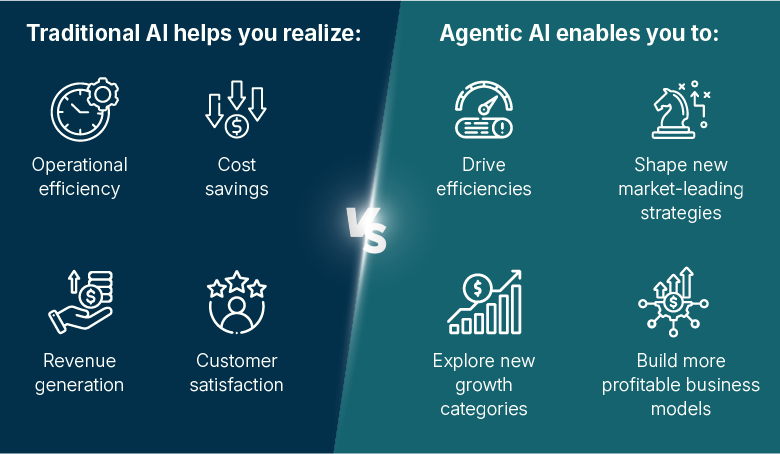
In our AI consulting approach, we help you identify whether you need a traditional AI or agentic AI push. In our AI consulting services, we further work on end-to-end solution development and deployment in your infrastructure.
Agentic AI for the C-suite: How agentic AI helps in decision-making to the C-suite through the JTBD lens
Agentic AI transforms how the C-suite approaches daily decision-making by addressing the three core “jobs” of the JTBD framework. It focuses on understanding the “real job” customers want to achieve while automating routine decisions to help executives prioritize innovation, growth, and strategic judgment.
1. Functional Jobs: Solve tangible business challenges
Agentic AI supports executives by automating routine operational decisions that traditionally require their oversight, enabling faster, more effective responses.
Did you know?
Most C-suite leaders spend 40% of their time on routine approvals, like pricing decisions or supplier evaluations, which could be automated.
Consider how agentic AI could transform your decision-making processes and lead to more strategic use of your time.
| Routine task | Time without agentic AI | Time with agentic AI | Time saved |
|---|---|---|---|
| Customer service escalations | 2-4 hours per week | < 15 minutes | 80%+ |
| Supplier contract adjustments | 3-6 hours per month | Automated suggestions | 90%+ |
| Pricing and discount approvals | 5-8 hours per month | Context-driven actions | 70%+ |
Result: Over 40% of operational hours are redirected to strategic work.
Agentic AI empowers the C-suite to convert these hours spent on functional jobs into strategic opportunities.
For example:
- Customer service escalations: Agentic AI handles customer complaints by autonomously analyzing them and pulling data from CRMs, customer policies, and past interactions. It finds out root causes and suggests immediate solutions or escalations only for critical decisions, such as changes to company policies or compensation approvals.
- Supplier contract adjustments: The AI monitors supply chain performance data and flags underperforming suppliers. It recommends contract renegotiations or replacements based on delivery trends, financial impacts, and quality metrics. Notably, top leaders will now give input only for high-impact supplier decisions.
2. Emotional Jobs: Build confidence and reduce stress
Agentic AI eases decision-making by offering precise recommendations for emotionally charged or high-stakes scenarios, by understanding the why behind every choice
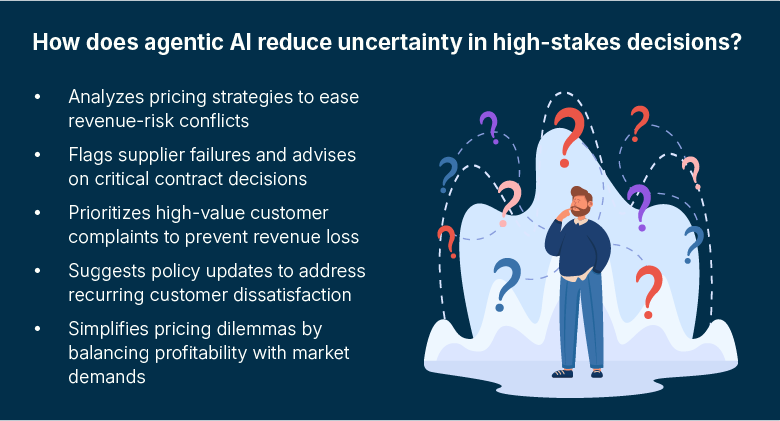
What makes agentic AI indispensable for emotional decisions?
- Holistic analysis: In a pricing dispute, Agentic AI doesn’t just consider CRM records, competitor pricing data, and financial reports individually. It integrates these sources to offer a clear, data-driven course of action. It thus ensures executives have a complete picture for making informed decisions quickly and confidently.
- Risk mitigation: Before approving supplier contracts, AI analyzes historical performance, market trends, and contract terms to highlight potential risks. It then presents actionable solutions, enabling executives to make well-informed decisions while minimizing exposure to future issues.
- Team performance reviews: By analyzing workforce productivity, sentiment surveys, and performance KPIs, the AI identifies team-wide inefficiencies and suggests coaching strategies or team restructuring plans. It ensures executives only need to make final decisions with complete clarity and context.
3. Social Jobs: Strengthen stakeholder trust
Agentic AI fosters confidence by ensuring decisions are transparent, explainable, and aligned with company goals.
Stakeholders demand clarity. Here’s how agentic AI delivers it:
- Customer policy adjustments: The AI identifies customer dissatisfaction or feedback patterns and recommends policy updates (e.g., return policies and warranty extensions). It provides detailed justifications for these changes, fostering trust among internal stakeholders and customers.
- Investor and board reporting: Agentic AI compiles real-time insights from financial, operational, and ESG data systems to create reports tailored to board or investor meetings. It highlights only critical points that require C-suite explanation. Thus, it saves time and gains stakeholder trust.
Suggested: While the above are the core jobs, when arise, people buy products or hire services, agentic AI goes further for a company. If you want to understand ‘how,’ consider going through this blog on the use cases and benefits of agentic AI for the insurance industry.
At the end,

CEOs expect more pressure over the next three years than they experienced over the previous five from technology, climate change and nearly every other megatrend affecting global business. The pressure to manage distractions and stay focused on core priorities intensifies.
Agentic AI helps the C-suite eliminate distractions from routine decisions. The technology also ensures they stay informed and control critical business operations. Simplifying functional, emotional, and social jobs allows executives to focus on creativity, strategic growth, innovation, and vision.
Thrive in an age of constant reinvention
Ready to witness the transformative power of RAG-powered AI agents in redefining your decision making?

The question is not whether you should embrace agentic AI. The question is: Can you afford not to?


